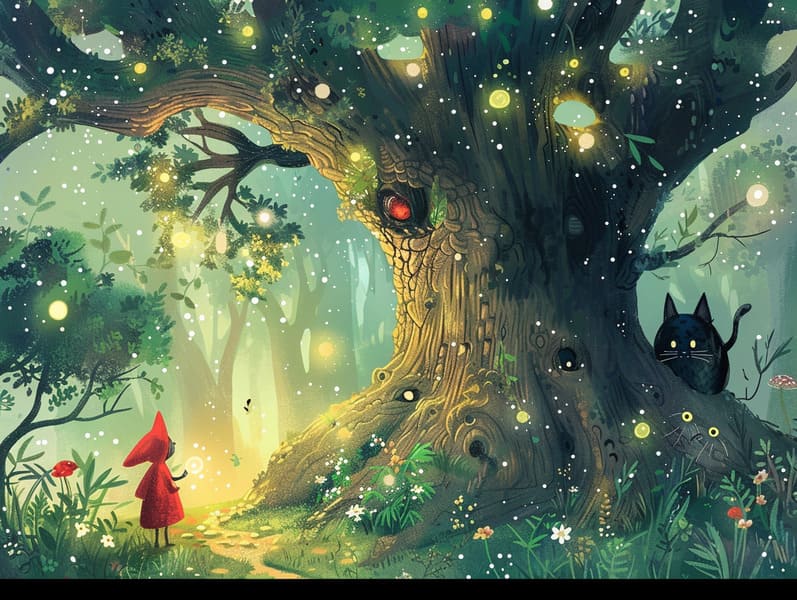
Old fairy tales have deep roots. These tales have been recounted from one generation to the next long before they were ever documented. They developed from a variety of traditions, including European traditions. They were initially shared among elders, often carrying themes and messages reflective of the societal norms and beliefs of the time.
The renowned Brothers Grimm, Jacob and Wilhelm Grimm, were among the first to compile and release many of these beloved narratives. Their compilation, "Grimm's Fairy Tales," included narratives like "Cinder Maid," "Little Brother and Little Sister," and "Little Snow White," which have since become cornerstones in the world of famous fairy tales. Similarly, Hans Andersen's enchanting tales, such as "The Little Mermaid," and "The Duckling that Could," have floated into hearts worldwide, ensuring their place in the pantheon of classic fairy tales.
Though they are centuries old, these tales remain as impactful as ever, especially as kids' bedtime tales. These charming stories are now available in diverse formats, including richly illustrated books, delightful animations, and digital storybooks.
Their unwavering allure can be connected to several fascinating points:
Crucial Morals: Classic fairy tales often provide important moral lessons. Narratives like "The Shepherd Boy and the Wolf" teach the importance of being truthful, while "The Hare and the Tortoise" highlight the qualities of resolve and unpretentiousness. These narratives offer kids clear distinctions between virtue and vice, shaping their moral compass in a subtle yet important way.
Compassion and Insight: Ancient fairy tales frequently feature personalities facing trials and tribulations, stimulating young listeners to sympathize with their struggles and applaud their triumphs. For instance, "Beauty's Beast" illustrates the importance of appreciating inner worth to perceive the inner self of a being, advancing tenderness and perception.
Cultural Understanding: Many ancient fairy tales are saturated in the cultural contexts from which they sprang. Engaging with these tales can provide fascinating glimpses into different backgrounds, nurturing a sense of world awareness and acknowledgment.
Fantasy and Imagination: The supernatural elements in old fairy tales—spells and potions—encourage children’s imaginative ideas. These narratives take readers to extraordinary realms, revitalizing innovative thinking and a sense of enchantment that continues a lifetime.
Classic fairy tales are not only charming but also educational. They serve as fantastical tools in developing various intellectual and emotional capacities in young ones. When ancient fairy tales are spoken, they improve linguistic abilities by presenting new linguistic elements and intricate sentence structures. This practice also fosters auditory skills and concentration, as young ones hang on every word, prepared to see what happens next.
Furthermore, deliberating the themes and characters of old fairy tales can improve logical thinking and problem-solving abilities. Young readers are led to detect patterns, forecast, and know cause and effect. These reflections also advance young ones utter their thoughts and feelings, boosting their emotional intelligence.
In today’s technological era, the presence of digital storybooks has made these fairy tales more reachable than ever. Digital sites and web apps make available extensive collections of bedtime fairy tales that can be browsed or listened to anytime, anywhere. Fairy tales recited are particularly common, making available an delightful method for children to enjoy these delightful tales. Spoken stories and read-out-loud stories move characters and settings to life, check it out often augmented by fantastical soundtracks and tunes that heighten the tale journey.
The enduring charm of ancient fairy tales lies in their ability to shift to modern society while sustaining their basic principles. Contemporary renditions of these tales often include more diverse figures and modern settings, making them familiar to today’s audience. However, the essential messages of valour, sympathy, and integrity remain unchanged, continuing to strike a chord with kids of all ages.
Old fairy tales also offer a sense of warmth and understanding. They put out a systematic narrative with a unmistakable beginning, middle, and end, often drawing to a close with the solving of conflicts and the triumph of good over bad. This dependability can be encouraging for kids, making available a sense of consistency in an dynamic world.
Timeless fairy tales continue to charm and inform new generations, maintaining their captivation and meaningfulness in modern society. As bedtime stories for kids, they extend a perfect blend of charm and enlightenment, developing moral values, empathy, and creativity. The accessibility of digital fairy tales and the sought after status of fairy tales recited affirm that these traditional stories remain obtainable to new generations.
By guarding and recounting these fairy tales, we continue to acknowledge the rich tapestry of myths and cultural heritage. Whether you are reading a vividly illustrated book, discovering a cyber collection, or listening to an sound book, the attraction of bedtime fairy tales is always within reach. These tales illustrate of the unending magic of tales and its ability to hold us together across generations and cultures.
Regardless if you are discovering a vividly illustrated book, browsing a virtual collection, or listening through an sound book, the elegance of timeless fairy tales is always within reach.
These stories show us of the consistent presence of fairy tales and its ability to connect us across generations and cultures, casting a charm that enchants and educates alike.